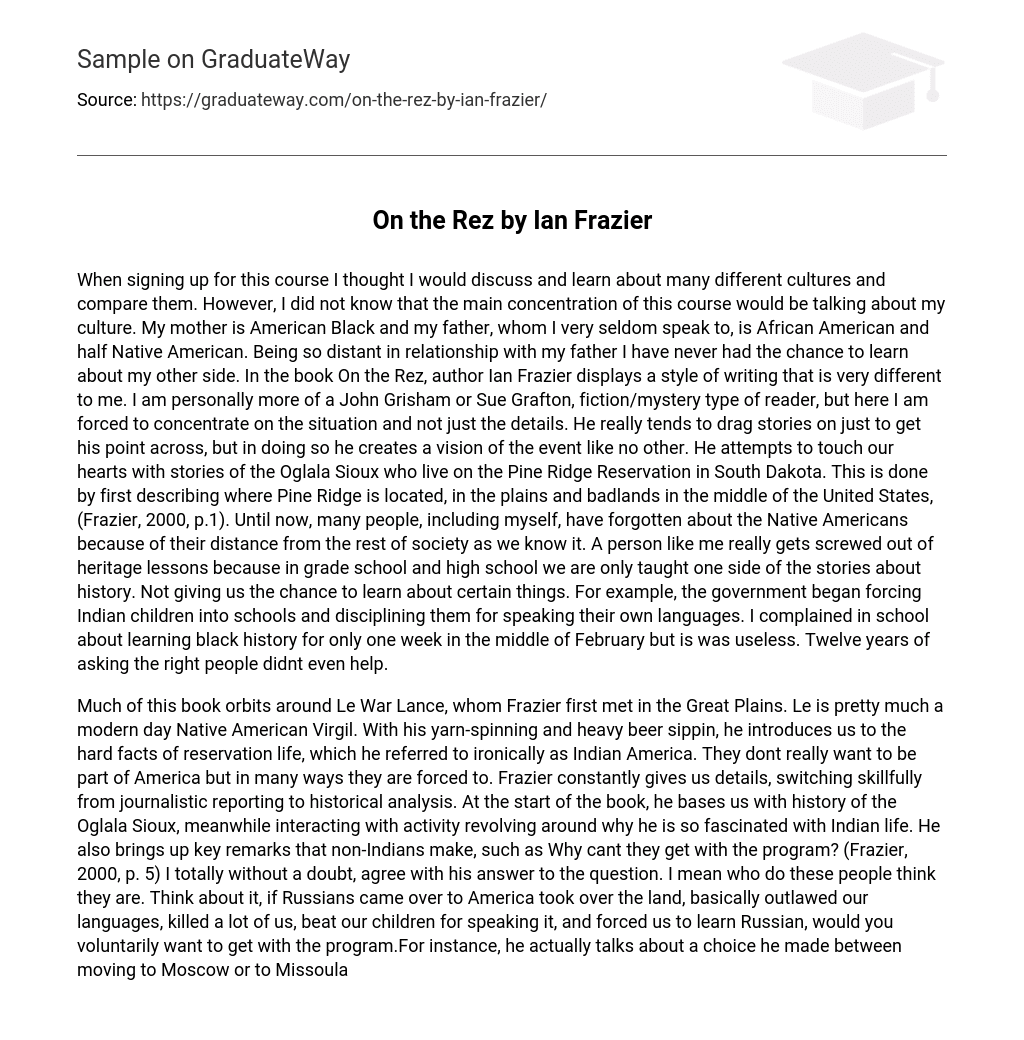Upon enrolling in this course, my initial expectation was to explore and compare various cultures. However, it quickly became evident that the main focus of the course was actually centered around my own culture. Specifically, my mother is African American while my father’s heritage comprises a mix of Native American and African American roots. Regrettably, due to limited communication with him, I have never had the opportunity to learn or delve into my Native American background.
In contrast to my usual preference for fiction and mystery writers such as John Grisham and Sue Grafton, Ian Frazier’s book On the Rez possesses a distinct writing style that diverges significantly. While I typically enjoy works that emphasize intricate details rather than overarching situations, Frazier deliberately prolongs his narratives in order to effectively convey his intended message. By documenting the lives of the Oglala Sioux residing on South Dakota’s Pine Ridge Reservation, he offers a unique perspective that evokes intense emotions.
Frazier commences by portraying Pine Ridge’s location amidst the plains and badlands of the United States (Frazier, 2000, p.1). Historically speaking, many individuals—myself included—have overlooked Native Americans as a result of their geographical isolation from mainstream society. Unfortunately, people like myself suffer from an inadequate understanding of our heritage due to biased approaches in history education within grade school and high school curricula.Even though I consistently expressed my concerns about the government’s policy of mandating English-only language for Indian children and disregarding their native languages, I was unable to fully address certain topics. Furthermore, despite my twelve-year-long effort to gain support, my attempts to advocate for a longer duration dedicated to studying black history beyond just one week in February were not successful.
The central figure in this book is Le War Lance, whom Frazier first encountered on the Great Plains. He is likened to a contemporary Native American Virgil, renowned for his storytelling and fondness for beer. Through Le, Frazier offers an ironic depiction of reservation life, which he labels as Indian America. Despite their desire to distance themselves from America, the Native Americans frequently find themselves compelled into assimilation. Frazier effectively blends journalism and historical analysis in his comprehensive portrayal of the Oglala Sioux tribe.
Throughout the book, Frazier delves into his fascination with Indian life and addresses comments made by non-Indians, such as questioning why they can’t “get with the program.” I strongly resonate with Frazier’s response to this query. He emphasizes how Native Americans have endured oppression and colonization by drawing parallels to a hypothetical scenario where Russians conquer America and suppress its native languages, resulting in forced assimilation.
Frazier recounts a personal experience when he had to decide between moving to Moscow or Missoula near the Indian reservations. Although he briefly contemplated living in Moscow, he ultimately realized that no one would comprehend him there. The reasons behind his choice to relocate to Montana remain unclear; it could have been influenced by both communism and convenience.
Throughout the text, we learn about the bravery of various Sioux heroes, both famous and lesser-known. One such individual is SuAnne Big Crow, a former high school basketball star who serves as a great inspiration. SuAnne’s perspective on life resonated with the author, as she enjoyed having fun, playing sports, and embracing people from diverse backgrounds. SuAnne’s impact reached many lives, including the author’s, and she demonstrated that one can assimilate into society while staying true to their own culture. The author believes that understanding different groups requires experiencing their lives firsthand, and though they may not change their own cultural beliefs, they are willing to listen to others. SuAnne’s story should serve as an inspiration to all readers, regardless of their opinions on Indian cultures. She effectively broke down barriers and allowed non-Indians to glimpse another side of her people. Through her pre-game dances, she expressed love for her community and what it represents.When she made a successful basket, she brought people closer together, fostering intercultural relationships among fans and players. Her passing left thousands of individuals she had met or befriended feeling heartbroken and uneasy. She touched numerous lives in various ways, from her family to friends, ensuring that her memory will endure. It is essential for everyone to have a radiant and vibrant personality like hers in their homes.
From personal reflections to objective discussion of present reservation issues and inspiring stories of pride and heroism, Ian Frazier captivates the audience with heartwarming tales. He provides insight into both the challenges faced by present-day Native society and the achievements, such as SuAnne scoring a high number of points in a single game. Frazier’s narratives cover a range of topics, including the prevalence of drinking problems among Native Americans.
Frazier, I. (2000). On the rez. New York: Farrar, Stratus, and Giroux.
Bibliography:





